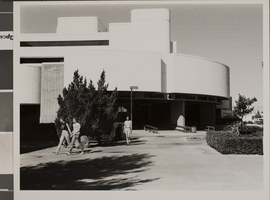Search the Special Collections and Archives Portal
Search Results

Fourth of July menu, July 4, 1890, The Coates
Date
1890-07-04
Archival Collection
Description
Note: Coat of arms with motto "Est voluntas Dei" and a greyhound and primroses (the Coates family crest) at top left of cover. "Table water from Bethsaida Springs." Restaurant: The Coates Location: Kansas City, Missouri, United States
Text

Slide of the neon sign for the Crystal Palace Gambling Hall, Laughlin, Nevada, 1986
Date
1986
Archival Collection
Description
A color image of the neon sign for the Crystal Palace Gambling Hall. Site Name: Crystal Palace Gambling Hall (Laughlin, Nev.)
Image

An exterior view of the Silver Slipper Gambling Hall: photographic film
Date
1960 (year approximate) to 1986 (year approximate)
Archival Collection
Description
An exterior view of the Silver Slipper Gambling Hall. A "Welcome Hunters" sign is visible above the main entrance. The Silver Slipper was a casino in Paradise, Nevada that operated from September 1950 to November 29, 1988. The building was designed by architect Martin Stern, Jr. Opened in 1950, the casino was built on the grounds of the Last Frontier Village[1] of the Hotel Last Frontier, and was originally named the Golden Slipper Saloon and Gambling Hall. The owner originally wanted to call it the Silver Slipper, but there already was an existing establishment with that name. The problem was solved when that small operation was purchased and closed, and the Golden Slipper became the Silver Slipper. The casino was known for its rotating slipper that sat atop the casino. In 2009, the Silver Slipper sign was restored and is now part of a display of vintage signs in the median along Las Vegas Boulevard North.
Image

Untitled sketch: figures entering music hall
Date
1975
Archival Collection
Description
Series II. Folies-Bergere production papers, designs, and photographs -- 15th Edition -- Set design drawings by William Morris
Image

Photograph of Midbar Kodesh Social Hall, Henderson (Nev.), November 10, 2016
Date
2016-11-10
Archival Collection
Description
Housed in the first building constructed at Midbar Kodesh Temple, the Social Hall provides space for gatherings. The Social hall was dedicated to the Feldman Family.
Image
Marion Allen remembers Anderson Mess Hall: interview video clip
Date
Unknown year
Description
Marion Allen remembers Anderson Mess Hall
Moving Image

Photograph of Frank and Estella Beam Hall, University of Nevada, Las Vegas, 1984
Date
1984
Archival Collection
Description
The exterior of the Frank and Estella Beam Hall.
Image

Photograph of Maude Frazier Hall, University of Nevada, Las Vegas, circa 1980s
Date
1980 to 1989
Archival Collection
Description
An exterior view of Maude Frazier Hall.
Image
Binion's Gambling Hall: archived website, 2016 to 2022
Level of Description
Other Level
Archival Collection
University of Nevada, Las Vegas Gaming Web Archive
To request this item in person:
Collection Number: MS-01020
Collection Name: University of Nevada, Las Vegas Gaming Web Archive
Box/Folder: N/A
Collection Name: University of Nevada, Las Vegas Gaming Web Archive
Box/Folder: N/A
Archival Component
Pagination
Refine my results
Content Type
Creator or Contributor
Subject
Archival Collection
Digital Project
Resource Type
Year
Material Type
Place
Language
Records Classification

